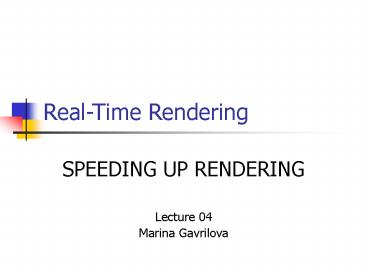Real-Time Rendering - PowerPoint PPT Presentation
Title:
Real-Time Rendering
Description:
Real-Time Rendering SPEEDING UP RENDERING Lecture 04 Marina Gavrilova Brief Outline Culling Hierarchical z-buffering Hierarchical Occlusion Map (HOM) Impostors and ... – PowerPoint PPT presentation
Number of Views:177
Avg rating:3.0/5.0
Title: Real-Time Rendering
1
Real-Time Rendering
- SPEEDING UP RENDERING
- Lecture 04
- Marina Gavrilova
2
Brief Outline
- Culling
- Hierarchical z-buffering
- Hierarchical Occlusion Map (HOM)
- Impostors and Nailboards
- Hierarchical image caching
- Level of Detail (LOD)
- Triangle Stripping
3
Culling
- To cut-off non-visible objects at an early stage
of the rendering pipeline - Backface culling Most frequently used culling
- Dot product of surface normal and view vector
- Clustered Culling Determine using 1 test whether
a group of polygon is visible or not
4
Hierarchical View Frustum Culling
- Bounding Volume (BV) Volume that encloses a
group of objects - Compute BV Hierarchy and store as Directed
Acyclic Graph (DAG) or tree - Leaf holds actual geometry, parent BV contains
several child BV - Most common BV Sphere, Axis Aligned Bounding Box
(AABB), Oriented Bounding Box (OBB)
Hierarchy of BV is often called a Scene Graph
5
Rendering Scene with Hierarchical BV
- Child is explored for visibility only if parent
is completely or partially visible
6
BSP trees for static scene
- Excellent for static scene
- Takes a long time to compute
- Efficient culling test
- AABB based BSP
- Take one plane of the box
- Divide objects into two sets
- Subsequent division
- Polygon Aligned BSP
- Choose one polygon as divider
- Use the chosen polygons plane to divide into two
partition - Recursively divide the rest
7
Rendering scene using BSP
- Polygon aligned BSP trees can be traversed to
find back to front order of objects - Render back to front no z-buffer needed
- Render front to back no need to redraw pixels
- Pixel span span of pixels in a row.
- No need to draw pixel spans
- BSP is also known as k-d trees in computational
geometry
8
Portal culling
- Used in architectural design
- Used in Computer games inside buildings with
doors - Occluders are large walls
- Compute Potentially visible set (PVS) from one
point of view - Divide the entire scene into cells (i.e. room)
- Doors and windows are called portals
- Method 1 impose a BSP on cells (align the
partitioning planes with the walls) - Method 2 Subdivide cells and identify portals
and construct a cell-to-cell visibility data
structure - Dramatic Speedup (up to 100 times) when scene is
very complex with many walls
9
Portal Culling (contd)
- It is a refinement process (diminishing view
frustum) - Reflection can be seen as another portal (with
associated PVS) - Used in Nintendo 64
10
Detail Culling
- Object to Screen Pixel Ratio The area of the
projected BV of an object (in number of pixels) - Omit objects whos Screen pixel ratio is too
small - Replace object with simpler model when screen
pixel ratio is low
11
Occlusion Culling
- Z-buffer is not sufficient for densely packed
objects (i.e. a forest) - Occlusion culling saves rendering time by
preventing occluded objects from being rendered - General algorithm
12
Hierarchical Z-buffering
- Hierarchical Visibility Algorithm (HV)
- Maintain scene model in an Octree
- Maintain a z-pyramid for occlusion test
- Recursively subdivide scene into octree boxes
(until each leaf containsltk primitives) - In 2D ? Quadtree representation
- Takes too much time to be generated in runtime
(only suitable for static scene)
13
HV algorithm
- To maintain z-pyramid recurse the furthest value
- Upto 100 times less depth test than standard
z-buffer
14
Other HV based techniques
- Hierarchical polygon tiling ? Very Efficient
- Without hardware implementation HV is too slow
for real-time graphics - Take advantage of frame-to-frame coherence
- Rendering antialiased scenes hierarchically
without error bounds (Greene and Kass) - Visibility skeleton method (Durand)
15
The Hierarchical Occlusion Map (HOM) algorithm
- Another efficient algorithm
- Occlusion is tested using two mechanism
- Depth Test
- Overlap Test
- Identify potentially good occluders
(preprocessing)
16
The HOM Algorithm
- Occlusion map
17
The HOM algorithm
- Hierarchy can be generated by hardware texture
MIP maps - Test of occlusion is based on a threshold opacity
18
Shadow Culling
- Find small number of large occluders
- Make use of separating planes and supporting
planes
19
Impostors
- Impostor image of a complex object that is
texture mapped onto a rectangle - Renders faster than the object
- Exploits frame-to-frame coherence
- Objects rendered to a texture from a particular
viewpoint - Rendered object is reused until the view point
changes significantly - Great for particle systems and complex objects
- Similar to billboards (dynamic/adaptive
billboard)
20
Nailboards
- Nailboard an Imposter frame with an attached
z-buffer (RGB?, ?z WRT impostor quad) - Avoids visibility problems of impostors
Real Object
Impostors (without ?)
Nailboard (2 bit ?)
Nailboard (8 bit ?)
21
Level Of Detail (LOD)
- Simpler objects as the object moves further away
from the camera - LOD is often equals to of triangles
- A more general measure for error metric is screen
pixel ratio - Problem When LOD changes popping effects occur
22
Correcting LOD popping effect
- Alpha LOD increase transparency of object as
distance increases - Object fades away
- More continuous
- Object becomes invisible
- Geomorph LOD
- Use different geometry and perform smooth
geometric interpolation between LOD - Smooth continuous transition of LOD
- Hard to implement
23
LOD management
- Define an error metric for the object LOD
- Optimally refine object to improve accuracy
- Restrict refinement operations to a constant
amount per frame
24
Triangle Stripping
- Define triangles of an objects as continuous
strip - Improves rendering performance
- SGI algorithm (greedy)
- Stripe algorithm
25
End of Lecture 04
- Questions?































